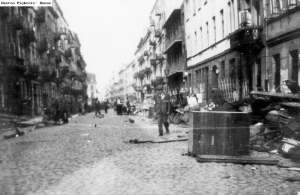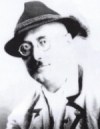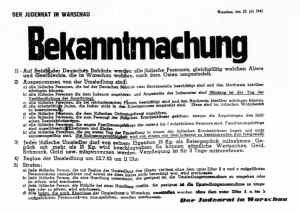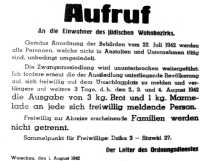In the months proceeding the mass deportations increasing unease was felt, under the impact of growing reports
and rumours about the deportations from other ghettos and places of Jewish habitation in occupied Poland.
 |
| After Expulsion |
Unrest and panic were created and grave doubts were raised among the ghetto population
by the night raids undertaken by the German police and security forces. These raids were
carried out according to prepared lists. The persons on the lists were seized in their homes,
taken out and shot at a nearby location. The most murderous raid took place on
18 April 1942,
when 52 persons were killed that night. This night became known as the "Night of Blood"
or the "Bartholomew’s Night".
 |
| v. Sammern |
Immediately after completion of
Treblinka the
Große Umsiedlungsaktion
("Great Resettlement Action") started on
22 July 1942.
Responsible leaders of the "Great Action" were
SS- und Polizeiführer Warschau
Ferdinand v. Sammern-Frankenegg,
Kommandeur der Sicherheitspolizei und des
Sicherheitsdienstes in Warschau, Dr
Ludwig Hahn and
SS-Sturmbannführer Hermann Höfle who acted as
representative of
Odilo Globocnik (
SS- und Polizeiführer Lublin).
Executive bodies: The Warsaw Order Police, a small unit of the Warsaw Security Police, a special
unit of
Volksdeutsche and the Jewish Order Service. Later SS-men from the forced labour camp in
Trawniki played the main part in the
ghetto liquidation.
The Jewish Order Service (Police) played an important role during the early stages of the "Great Action".
The Jewish Police commander
Josef Szerynski had been arrested by the Germans on
1 May 1942, on charges of smuggling furs from the ghetto to the Aryan side
of the city.
Jakob Lejkin, his deputy, took over the command and
exactly carried out the German orders, saying that it is better not to leave it to the cruel Germans.
The 2,000 - 2,500 Jewish policemen and their families were promised immunity by the Germans for their
co-operation. As the "action" progressed they began to understand that they were not more than a tool of the
Germans and their future like ordinary Jews was clouded in doubt. Therefore they began to desert in droves.
The German's response: each policeman was personally ordered to bring in five heads per day for deportation.
Those who did not fulfill this order were threatened with having their relatives transported to make up the
difference.
The SS directed the deportations from two centres in the ghetto. The
Aktion Reinhard command, which consisted
of a dozen SS officers, sergeants and soldiers set up its headquarters at
103 Zelazna Street (Ul. Zelazna), after having evicted the Jews from the building.
Ber Warman, a Jewish policeman, who guarded
103 Zelazna Street, wrote
at the
end of August / early September 1942 that SS men started to live there. Before
end of August 1942 the
Befehlsstelle (order HQ) was on
17 Ogrodowa Street, at the Jewish police
headquarters. At the door to one of the rooms was a plaque that read
Gastzimmer des SS-Sonderkommandos
Treblinka ("Guestroom of the SS Special Command Treblinka").
The HQ on
Ogrodowa Street was mainly manned with SS and
Gestapo-men who
has been stationed in Warsaw for some time. The most prominent members of this group were
Hohmann, Witosek,
Jesuiter and Stabenow. Tempo and character of the
"resettlement" actions were dominated by
Karl-Georg Brandt and
Gerhard Mende.
 |
| Announcement #1 |
At 10 a.m. on
22 July 1942 Höfle, Michalsen,
Worthoff and
other officers of
Aktion Reinhard visited the
Judenrat.
Höfle
dictated to the
Judenrat the German conditions for the "resettlement to the east".
In this way the
Judenrat was forced to help "cleaning" the ghetto. The main orders were:
All Jews will be resettled to the east, regardless of age and sex.
With the exception of:
Jews working for German institutions or companies
Jews working for the Judenrat
Jewish hospitals' staff
Members of the Jewish Order Service
Wifes and children of above-mentioned persons
Patients of a Jewish hospital on the day of resettlement.
Each person which will be resettled is allowed taking along 15 kg luggage and all valuables:
Gold, jewellery, money etc.
Provisions for three days is necessary.
The resettlement will start on 22 July 1942, 11 o'clock (11 a.m.).
The Judenrat is responsible for delivery of 6,000 persons daily until 4 p.m..
Assembly point is the Jewish hospital at Stawki Street.
On 22 July 1942, the Jewish hospital at Stawki Street
has to be emptied so that the building can be used for the people being resettled.
The Judenrat has to announce the German orders.
Punishments:
Each Jew who is leaving the ghetto during the resettlement action will be shot.
Each Jew who is acting against the resettlement will be shot.
Each Jew who doesn't belong to the above-mentioned persons and who will be discovered in
Warsaw after the resettlement action will be shot.
The first contingents put together by the Judenrat consisted of refugee assembly institutions,
prisons and old people's homes.
If these orders will not be carried out, a corresponding number of hostages will be shot.
 |
| Announcement #2 |
When
SS-Hauptsturmführer Worthoff ordered to
provide 10,000 Jews for the
24 July 1942, including children of a children's
transport, the
Judenrat leader
Adam Czerniakow committed suicide.
His successor became
Marek Lichtenbaum.
The Jewish order service took over the control. It was responsible for hanging up posters on 29 July,
announcing that each person who will volunteer for resettlement will get 3 kg bread and 1 kg marmalade.
Because of starvation many Jews followed that announcement. The Germans provided 180,000 kg bread and
36,000 kg marmalade.
On
23 July 1942, the Jewish underground organisations met. Its leaders refused
organizing resistance.
Only the organisation of the young Zionists, Hashomer Hatzair, organized a propaganda action in the ghetto,
informing on handbills that the deportees will be sent to a death camp and not to work. The Jews in the ghetto
supposed that it was just a German provocation.
The assembly point
(Umschlagplatz)
was formerly used by the
Transferstelle as a corridor for transports to and from the ghetto. In the
adjoining yard, which was surrounded by a high fence, was the abandoned Jewish hospital, into which the victims
were crowded until the freight trains arrived. The Germans organized a
Dulag (
Durchgangslager -
transit camp) on
Leszno Street. From there after a selection on the
Umschlagplatz Jews being able to work were sent to different work camps, including the KZ
Majdanek.
In
July 1942, 64,606 Jews were deported to
Treblinka.
This number doesn't include
the people who were shot on the streets and in the houses in course of "cleaning" the buildings.
Until
29 July 1942, the round ups were organized only by the Jewish police in the ghetto.
Afterwards the "actions" were carried out by members of
Aktion Reinhard.
In
August 1942, the deportations continued with the same relentless efficiency.
During the first week in
August the
Janusz Korczak
orphanage was closed.
200 children marched through the ghetto to the
Umschlagplatz, accompanied by the
old doctor and his long-time assistant
Stefania Wilczynska.
This incident became a legend.
 |
| Janusz Korczak |
Between
19 and 21 August 1942, the Warsaw Ghetto saw a break in the
Aktion:
During these days the Jews from the towns near Warsaw were deported to
Treblinka:
Otwock, Falenica, Miedzeszyn and
Minsk
Mazowiecki. In fact the number of deportees to
Treblinka in August
could be estimated at around 135,000 people.
On
23 August 1942,
Jankiel Wiernik was deported to
Treblinka. He was one of a few
Treblinka
survivors, who participated in the
Treblinka revolt. Read
his story about his deportation!
From
28 August until 3 September 1942, there was another break in the
deportations.This fact could be connected with the backlog at
Treblinka,
where
Eberl (the commandant) had allowed more transports to arrive
than the camp could manage. The inadequate gassing facilities at
Treblinka
led to a complete breakdown of the camp's operation.
Irmfried Eberl was
relieved of his command and
Christian Wirth was ordered by
Odilo Globocnik to dispose of the mass of corpses. All transports
were suspended whilst order was restored.
In
August 1942, the underground organisation of "Bund" in the Warsaw Ghetto sent
their activist
Zalman Friedrich to discover what had happend to the
transports from the ghetto. In
Sokolów Podlaski near
Treblinka he was informed by Polish railway workers that
every day a
freight trains (with people on board) passed the town to
Treblinka. After several hours these trains returned empty. There were no
food supplies to the camp...
On
Sokolów Podlaski market
Friedrich
met two
naked Jews who had escaped from
Treblinka. They described what had happend to
the deportees. The information about
Treblinka and the fate of the transports
from Warsaw Ghetto were confirmed by
Dawid Nowodworski who could escape from
Treblinka. He returned to the Warsaw Ghetto in
late August 1942.
On
14 August 1942, from the Warsaw Ghetto
Dulag 1,260 Jews were sent to
Lublin. About 1,000 of them were sent to the concentration camp
Majdanek, others to the work camp on
Lipowa Street 7 in
Lublin.
The last phase of the "Great Action" opened on
6 September 1942. Its main feature
was a comprehensive selection that went on until
10 September 1942.
The Jews having a permission for work (35,000 permissions have been handed out
by the Germans) were concentrated in a "cauldron" in the
David quarters
("Cauldron" means "Kesl" in Yiddish, "Kociol" in Polish). During this selection 35,885 Jews were deported,
according to the
Judenrat lists
(published in
1988, Warsaw State Archive). 2,648 were shot on the spot
and 60 committed suicide.
After this selection approximately 60,000 Jews remained in the ghetto.
On
15 September 1942, 2,100 Jews from Warsaw (among them 150 Jewish policeman)
were sent to
Lublin. 600 of them were sent to the work camp on
7 Lipowa Street, 60 to the
Flugplatz Camp, and others to
KZ Majdanek. Their names are partially avaible at the
archive of the State Museum
Majdanek in
Lublin.
On
24 September 1942,
SS-Untersturmführer Karl
Brandt proclaimed the end of the resettlement action in the Warsaw Ghetto.
According to German sources 253,742 Jews were deported. According to Jewish sources
270,120 were sent to
Treblinka, 10,300 died in the ghetto, 11,580 were sent
to
Dulag (among them more than 3,500 were deported to
Lublin) and 8,000
escaped from the ghetto.
Exact figures about the Warsaw Ghetto drama are partially available but they differ.
Jews were deported to the ghetto, escaped from it, were sent to forced labour camps,
died by starvation and epidemics, perished somewhere in hidden places or lost their lifes
in the struggle against the Germans. Last but not least too many notes got lost and witnesses
died before they could tell about their observations.
Photos: GFH
Sources:
T. Berenstein: Zydzi warszawscy w hitlerowskich obozach pracy przymusowej. Biuletyn ZIH, No.67 (1968)
B. Engelking, J. Leociak: Getto warszawskie. Przewodnik po nieistniejacym miescie. Warszawa 2001
Tak bylo... Sprawozdania z warszawskiego getta 1939-1943. (Wybór). Oprac. J. Adamska,
J. Kazmierska, R. Sakowska. Warszawa 1988
Archive of the State Museum Majdanek
Encylopedia of the Holocaust
Yisrael Gutman: The Jews of Warsaw,1939-1943: Ghetto, Underground, Revolt. Bloomington:
Indiana University Press, 1982.
The Diary of Adam Czneriakow
Stanislaw Adler: In the Warsaw Ghetto
© ARC (http://www.deathcamps.org) 2005












